CNA155 Clinical Case Reasoning Report: Concussion Case of Mia Roberts
VerifiedAdded on 2022/09/23
|7
|1906
|22
Report
AI Summary
This clinical case reasoning report focuses on a 12-year-old girl named Mia Roberts who presented to the emergency department with symptoms of a concussion following a head injury during a basketball game. The report meticulously outlines the patient's situation, including her symptoms of headache, nausea, loss of appetite, fatigue, and behavioral changes. It details the cues and information gathered, such as her age, gender, and the mechanism of injury, highlighting the risk factors associated with concussion. The report then delves into the process and information, discussing the diagnostic approach, which includes a clinical interview, neurological tests (such as PET scan, MMRI, and functional MRI), and the significance of her age and injury location. The analysis integrates relevant research findings on concussion, emphasizing the vulnerability of the developing brain and the importance of comprehensive assessment and management. The report concludes with a hypothesis that Mia's condition might improve with proper assessment and treatment, offering a detailed exploration of the case and the clinical reasoning involved.
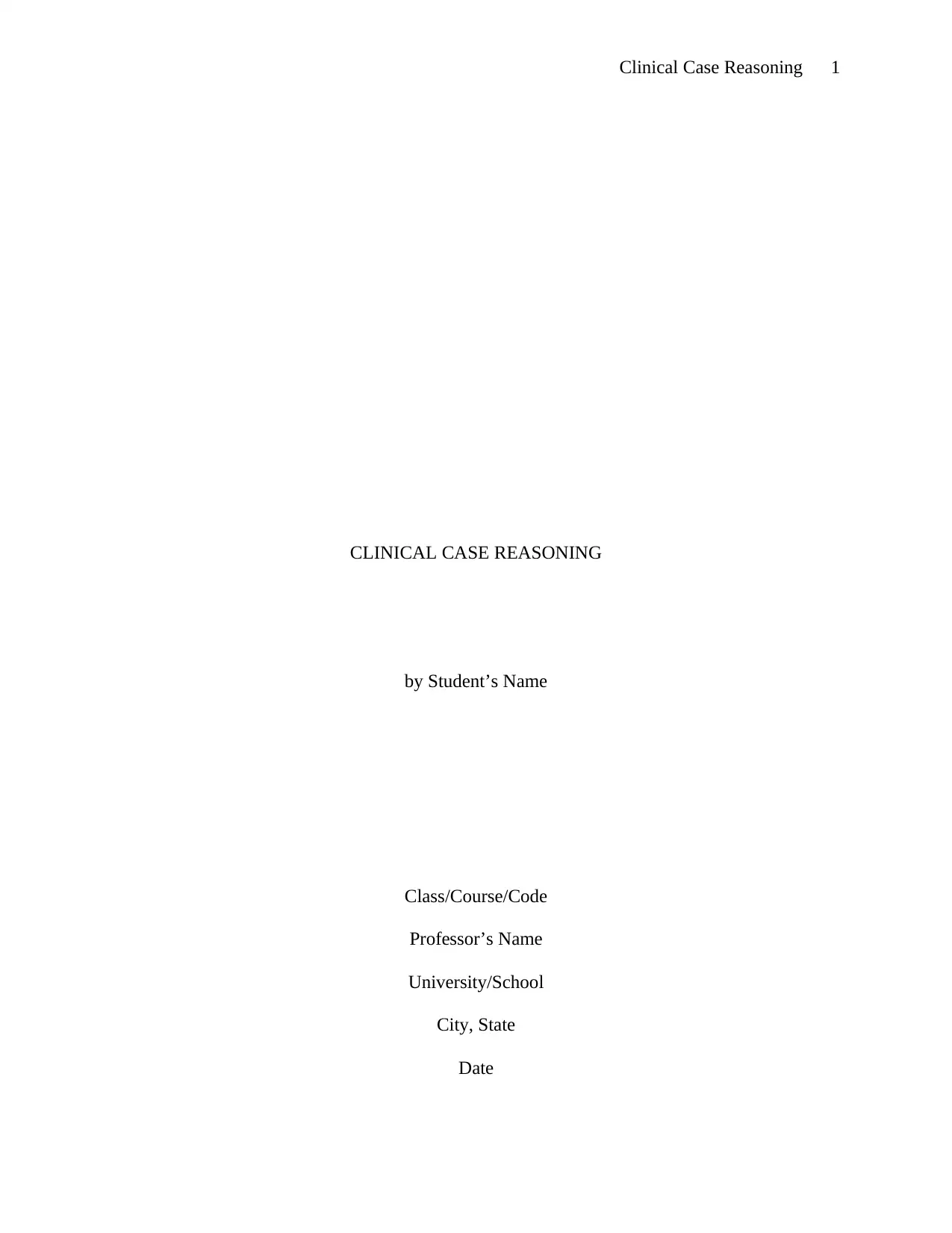
Clinical Case Reasoning 1
CLINICAL CASE REASONING
by Student’s Name
Class/Course/Code
Professor’s Name
University/School
City, State
Date
CLINICAL CASE REASONING
by Student’s Name
Class/Course/Code
Professor’s Name
University/School
City, State
Date
Paraphrase This Document
Need a fresh take? Get an instant paraphrase of this document with our AI Paraphraser
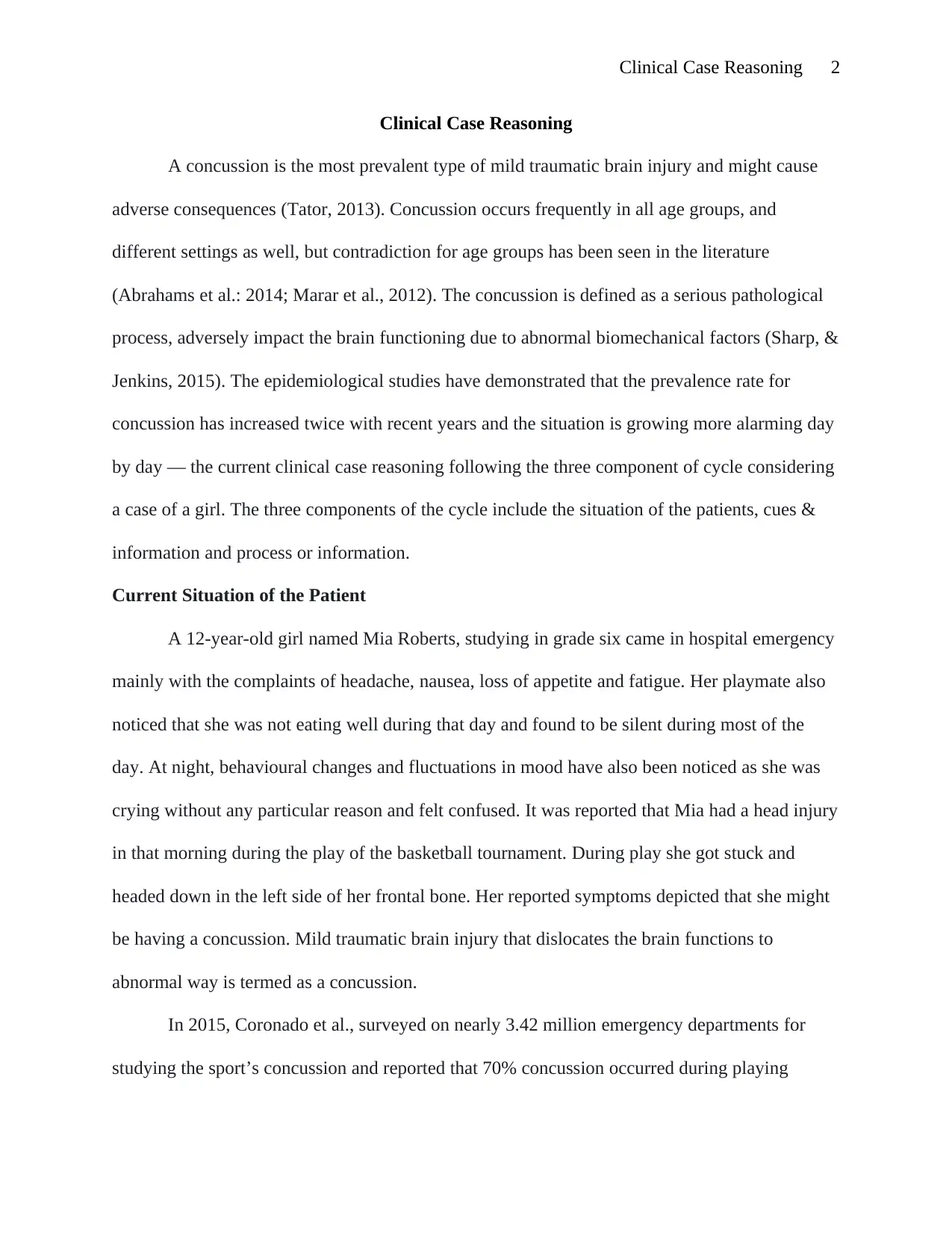
Clinical Case Reasoning 2
Clinical Case Reasoning
A concussion is the most prevalent type of mild traumatic brain injury and might cause
adverse consequences (Tator, 2013). Concussion occurs frequently in all age groups, and
different settings as well, but contradiction for age groups has been seen in the literature
(Abrahams et al.: 2014; Marar et al., 2012). The concussion is defined as a serious pathological
process, adversely impact the brain functioning due to abnormal biomechanical factors (Sharp, &
Jenkins, 2015). The epidemiological studies have demonstrated that the prevalence rate for
concussion has increased twice with recent years and the situation is growing more alarming day
by day — the current clinical case reasoning following the three component of cycle considering
a case of a girl. The three components of the cycle include the situation of the patients, cues &
information and process or information.
Current Situation of the Patient
A 12-year-old girl named Mia Roberts, studying in grade six came in hospital emergency
mainly with the complaints of headache, nausea, loss of appetite and fatigue. Her playmate also
noticed that she was not eating well during that day and found to be silent during most of the
day. At night, behavioural changes and fluctuations in mood have also been noticed as she was
crying without any particular reason and felt confused. It was reported that Mia had a head injury
in that morning during the play of the basketball tournament. During play she got stuck and
headed down in the left side of her frontal bone. Her reported symptoms depicted that she might
be having a concussion. Mild traumatic brain injury that dislocates the brain functions to
abnormal way is termed as a concussion.
In 2015, Coronado et al., surveyed on nearly 3.42 million emergency departments for
studying the sport’s concussion and reported that 70% concussion occurred during playing
Clinical Case Reasoning
A concussion is the most prevalent type of mild traumatic brain injury and might cause
adverse consequences (Tator, 2013). Concussion occurs frequently in all age groups, and
different settings as well, but contradiction for age groups has been seen in the literature
(Abrahams et al.: 2014; Marar et al., 2012). The concussion is defined as a serious pathological
process, adversely impact the brain functioning due to abnormal biomechanical factors (Sharp, &
Jenkins, 2015). The epidemiological studies have demonstrated that the prevalence rate for
concussion has increased twice with recent years and the situation is growing more alarming day
by day — the current clinical case reasoning following the three component of cycle considering
a case of a girl. The three components of the cycle include the situation of the patients, cues &
information and process or information.
Current Situation of the Patient
A 12-year-old girl named Mia Roberts, studying in grade six came in hospital emergency
mainly with the complaints of headache, nausea, loss of appetite and fatigue. Her playmate also
noticed that she was not eating well during that day and found to be silent during most of the
day. At night, behavioural changes and fluctuations in mood have also been noticed as she was
crying without any particular reason and felt confused. It was reported that Mia had a head injury
in that morning during the play of the basketball tournament. During play she got stuck and
headed down in the left side of her frontal bone. Her reported symptoms depicted that she might
be having a concussion. Mild traumatic brain injury that dislocates the brain functions to
abnormal way is termed as a concussion.
In 2015, Coronado et al., surveyed on nearly 3.42 million emergency departments for
studying the sport’s concussion and reported that 70% concussion occurred during playing
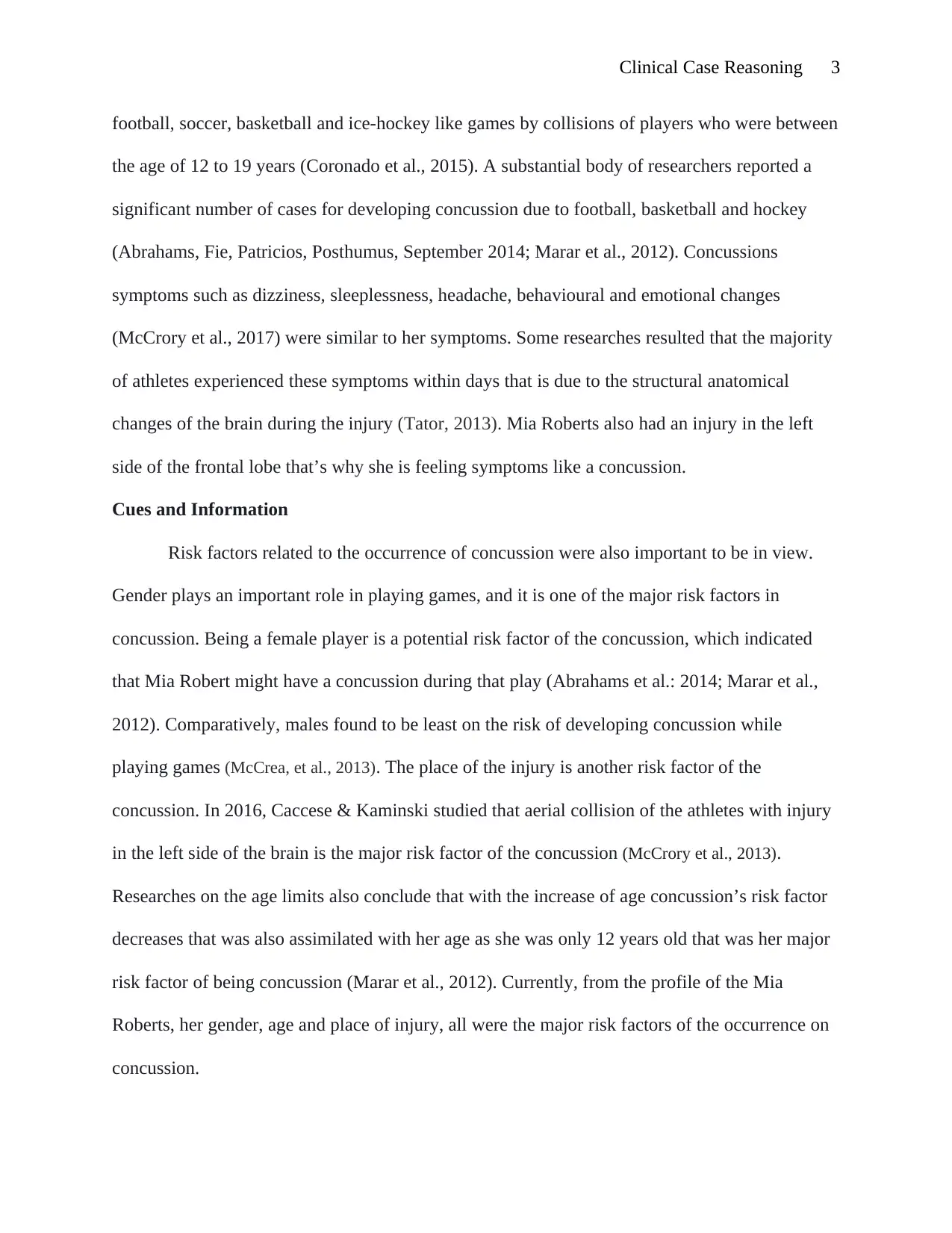
Clinical Case Reasoning 3
football, soccer, basketball and ice-hockey like games by collisions of players who were between
the age of 12 to 19 years (Coronado et al., 2015). A substantial body of researchers reported a
significant number of cases for developing concussion due to football, basketball and hockey
(Abrahams, Fie, Patricios, Posthumus, September 2014; Marar et al., 2012). Concussions
symptoms such as dizziness, sleeplessness, headache, behavioural and emotional changes
(McCrory et al., 2017) were similar to her symptoms. Some researches resulted that the majority
of athletes experienced these symptoms within days that is due to the structural anatomical
changes of the brain during the injury (Tator, 2013). Mia Roberts also had an injury in the left
side of the frontal lobe that’s why she is feeling symptoms like a concussion.
Cues and Information
Risk factors related to the occurrence of concussion were also important to be in view.
Gender plays an important role in playing games, and it is one of the major risk factors in
concussion. Being a female player is a potential risk factor of the concussion, which indicated
that Mia Robert might have a concussion during that play (Abrahams et al.: 2014; Marar et al.,
2012). Comparatively, males found to be least on the risk of developing concussion while
playing games (McCrea, et al., 2013). The place of the injury is another risk factor of the
concussion. In 2016, Caccese & Kaminski studied that aerial collision of the athletes with injury
in the left side of the brain is the major risk factor of the concussion (McCrory et al., 2013).
Researches on the age limits also conclude that with the increase of age concussion’s risk factor
decreases that was also assimilated with her age as she was only 12 years old that was her major
risk factor of being concussion (Marar et al., 2012). Currently, from the profile of the Mia
Roberts, her gender, age and place of injury, all were the major risk factors of the occurrence on
concussion.
football, soccer, basketball and ice-hockey like games by collisions of players who were between
the age of 12 to 19 years (Coronado et al., 2015). A substantial body of researchers reported a
significant number of cases for developing concussion due to football, basketball and hockey
(Abrahams, Fie, Patricios, Posthumus, September 2014; Marar et al., 2012). Concussions
symptoms such as dizziness, sleeplessness, headache, behavioural and emotional changes
(McCrory et al., 2017) were similar to her symptoms. Some researches resulted that the majority
of athletes experienced these symptoms within days that is due to the structural anatomical
changes of the brain during the injury (Tator, 2013). Mia Roberts also had an injury in the left
side of the frontal lobe that’s why she is feeling symptoms like a concussion.
Cues and Information
Risk factors related to the occurrence of concussion were also important to be in view.
Gender plays an important role in playing games, and it is one of the major risk factors in
concussion. Being a female player is a potential risk factor of the concussion, which indicated
that Mia Robert might have a concussion during that play (Abrahams et al.: 2014; Marar et al.,
2012). Comparatively, males found to be least on the risk of developing concussion while
playing games (McCrea, et al., 2013). The place of the injury is another risk factor of the
concussion. In 2016, Caccese & Kaminski studied that aerial collision of the athletes with injury
in the left side of the brain is the major risk factor of the concussion (McCrory et al., 2013).
Researches on the age limits also conclude that with the increase of age concussion’s risk factor
decreases that was also assimilated with her age as she was only 12 years old that was her major
risk factor of being concussion (Marar et al., 2012). Currently, from the profile of the Mia
Roberts, her gender, age and place of injury, all were the major risk factors of the occurrence on
concussion.
⊘ This is a preview!⊘
Do you want full access?
Subscribe today to unlock all pages.

Trusted by 1+ million students worldwide
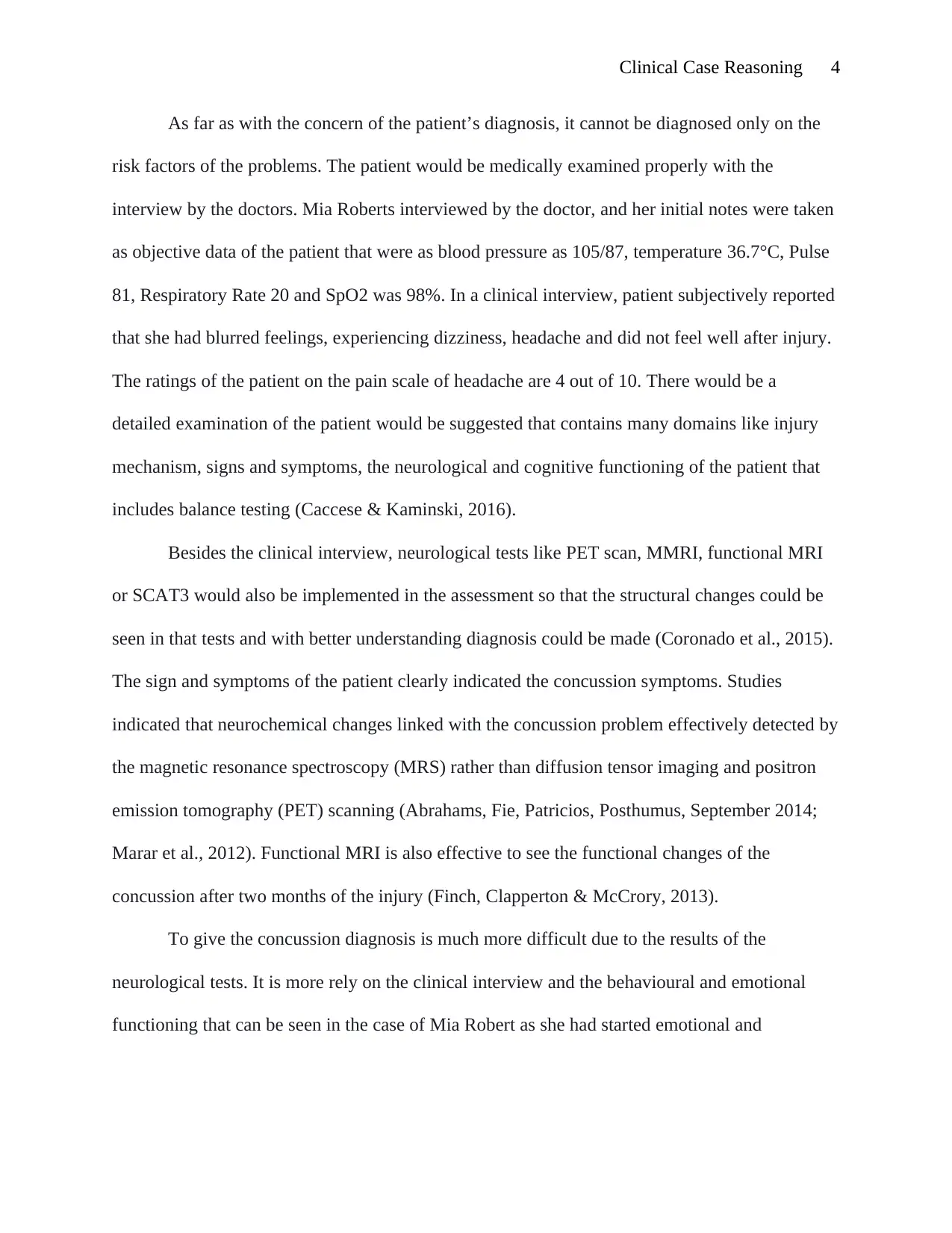
Clinical Case Reasoning 4
As far as with the concern of the patient’s diagnosis, it cannot be diagnosed only on the
risk factors of the problems. The patient would be medically examined properly with the
interview by the doctors. Mia Roberts interviewed by the doctor, and her initial notes were taken
as objective data of the patient that were as blood pressure as 105/87, temperature 36.7°C, Pulse
81, Respiratory Rate 20 and SpO2 was 98%. In a clinical interview, patient subjectively reported
that she had blurred feelings, experiencing dizziness, headache and did not feel well after injury.
The ratings of the patient on the pain scale of headache are 4 out of 10. There would be a
detailed examination of the patient would be suggested that contains many domains like injury
mechanism, signs and symptoms, the neurological and cognitive functioning of the patient that
includes balance testing (Caccese & Kaminski, 2016).
Besides the clinical interview, neurological tests like PET scan, MMRI, functional MRI
or SCAT3 would also be implemented in the assessment so that the structural changes could be
seen in that tests and with better understanding diagnosis could be made (Coronado et al., 2015).
The sign and symptoms of the patient clearly indicated the concussion symptoms. Studies
indicated that neurochemical changes linked with the concussion problem effectively detected by
the magnetic resonance spectroscopy (MRS) rather than diffusion tensor imaging and positron
emission tomography (PET) scanning (Abrahams, Fie, Patricios, Posthumus, September 2014;
Marar et al., 2012). Functional MRI is also effective to see the functional changes of the
concussion after two months of the injury (Finch, Clapperton & McCrory, 2013).
To give the concussion diagnosis is much more difficult due to the results of the
neurological tests. It is more rely on the clinical interview and the behavioural and emotional
functioning that can be seen in the case of Mia Robert as she had started emotional and
As far as with the concern of the patient’s diagnosis, it cannot be diagnosed only on the
risk factors of the problems. The patient would be medically examined properly with the
interview by the doctors. Mia Roberts interviewed by the doctor, and her initial notes were taken
as objective data of the patient that were as blood pressure as 105/87, temperature 36.7°C, Pulse
81, Respiratory Rate 20 and SpO2 was 98%. In a clinical interview, patient subjectively reported
that she had blurred feelings, experiencing dizziness, headache and did not feel well after injury.
The ratings of the patient on the pain scale of headache are 4 out of 10. There would be a
detailed examination of the patient would be suggested that contains many domains like injury
mechanism, signs and symptoms, the neurological and cognitive functioning of the patient that
includes balance testing (Caccese & Kaminski, 2016).
Besides the clinical interview, neurological tests like PET scan, MMRI, functional MRI
or SCAT3 would also be implemented in the assessment so that the structural changes could be
seen in that tests and with better understanding diagnosis could be made (Coronado et al., 2015).
The sign and symptoms of the patient clearly indicated the concussion symptoms. Studies
indicated that neurochemical changes linked with the concussion problem effectively detected by
the magnetic resonance spectroscopy (MRS) rather than diffusion tensor imaging and positron
emission tomography (PET) scanning (Abrahams, Fie, Patricios, Posthumus, September 2014;
Marar et al., 2012). Functional MRI is also effective to see the functional changes of the
concussion after two months of the injury (Finch, Clapperton & McCrory, 2013).
To give the concussion diagnosis is much more difficult due to the results of the
neurological tests. It is more rely on the clinical interview and the behavioural and emotional
functioning that can be seen in the case of Mia Robert as she had started emotional and
Paraphrase This Document
Need a fresh take? Get an instant paraphrase of this document with our AI Paraphraser
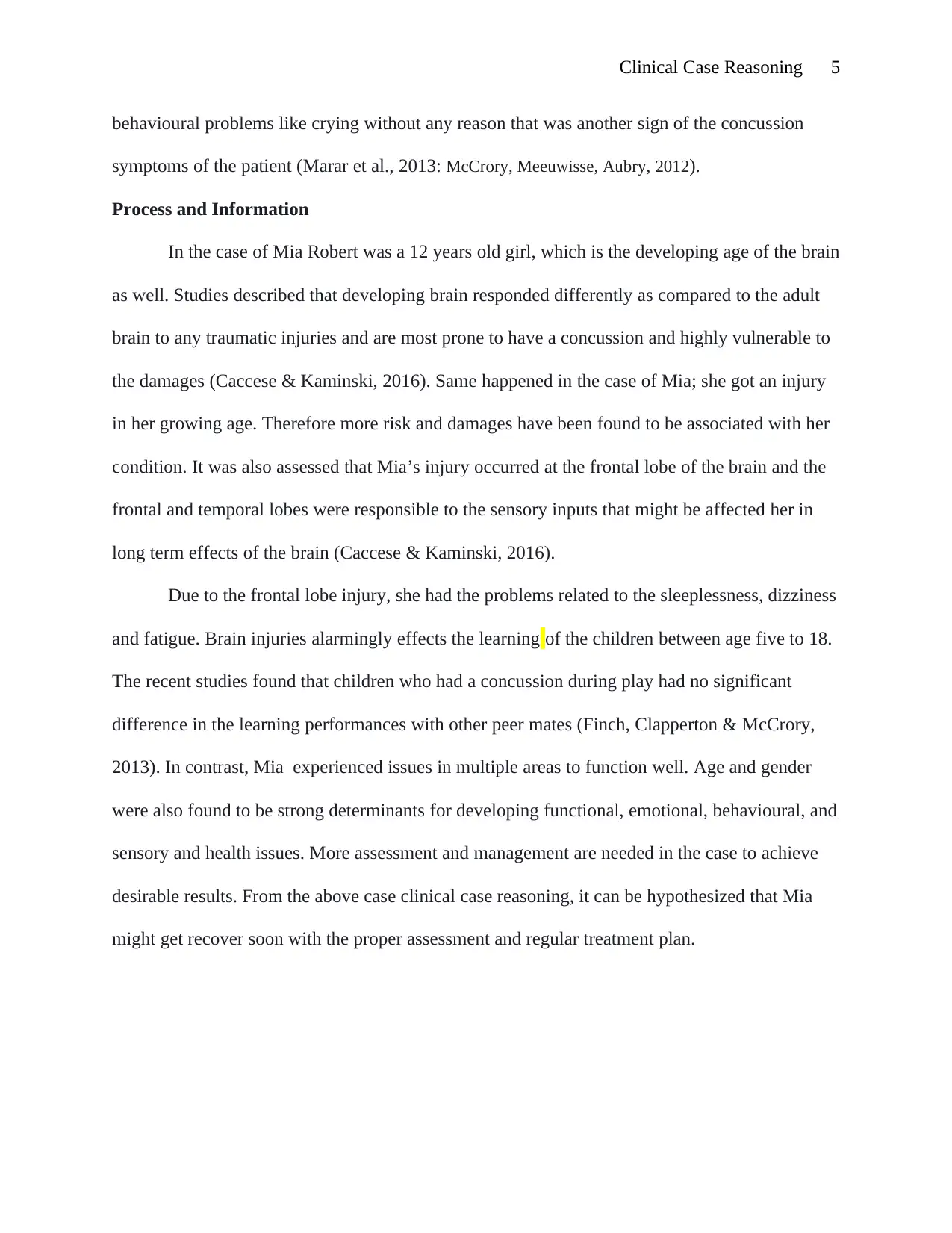
Clinical Case Reasoning 5
behavioural problems like crying without any reason that was another sign of the concussion
symptoms of the patient (Marar et al., 2013: McCrory, Meeuwisse, Aubry, 2012).
Process and Information
In the case of Mia Robert was a 12 years old girl, which is the developing age of the brain
as well. Studies described that developing brain responded differently as compared to the adult
brain to any traumatic injuries and are most prone to have a concussion and highly vulnerable to
the damages (Caccese & Kaminski, 2016). Same happened in the case of Mia; she got an injury
in her growing age. Therefore more risk and damages have been found to be associated with her
condition. It was also assessed that Mia’s injury occurred at the frontal lobe of the brain and the
frontal and temporal lobes were responsible to the sensory inputs that might be affected her in
long term effects of the brain (Caccese & Kaminski, 2016).
Due to the frontal lobe injury, she had the problems related to the sleeplessness, dizziness
and fatigue. Brain injuries alarmingly effects the learning of the children between age five to 18.
The recent studies found that children who had a concussion during play had no significant
difference in the learning performances with other peer mates (Finch, Clapperton & McCrory,
2013). In contrast, Mia experienced issues in multiple areas to function well. Age and gender
were also found to be strong determinants for developing functional, emotional, behavioural, and
sensory and health issues. More assessment and management are needed in the case to achieve
desirable results. From the above case clinical case reasoning, it can be hypothesized that Mia
might get recover soon with the proper assessment and regular treatment plan.
behavioural problems like crying without any reason that was another sign of the concussion
symptoms of the patient (Marar et al., 2013: McCrory, Meeuwisse, Aubry, 2012).
Process and Information
In the case of Mia Robert was a 12 years old girl, which is the developing age of the brain
as well. Studies described that developing brain responded differently as compared to the adult
brain to any traumatic injuries and are most prone to have a concussion and highly vulnerable to
the damages (Caccese & Kaminski, 2016). Same happened in the case of Mia; she got an injury
in her growing age. Therefore more risk and damages have been found to be associated with her
condition. It was also assessed that Mia’s injury occurred at the frontal lobe of the brain and the
frontal and temporal lobes were responsible to the sensory inputs that might be affected her in
long term effects of the brain (Caccese & Kaminski, 2016).
Due to the frontal lobe injury, she had the problems related to the sleeplessness, dizziness
and fatigue. Brain injuries alarmingly effects the learning of the children between age five to 18.
The recent studies found that children who had a concussion during play had no significant
difference in the learning performances with other peer mates (Finch, Clapperton & McCrory,
2013). In contrast, Mia experienced issues in multiple areas to function well. Age and gender
were also found to be strong determinants for developing functional, emotional, behavioural, and
sensory and health issues. More assessment and management are needed in the case to achieve
desirable results. From the above case clinical case reasoning, it can be hypothesized that Mia
might get recover soon with the proper assessment and regular treatment plan.
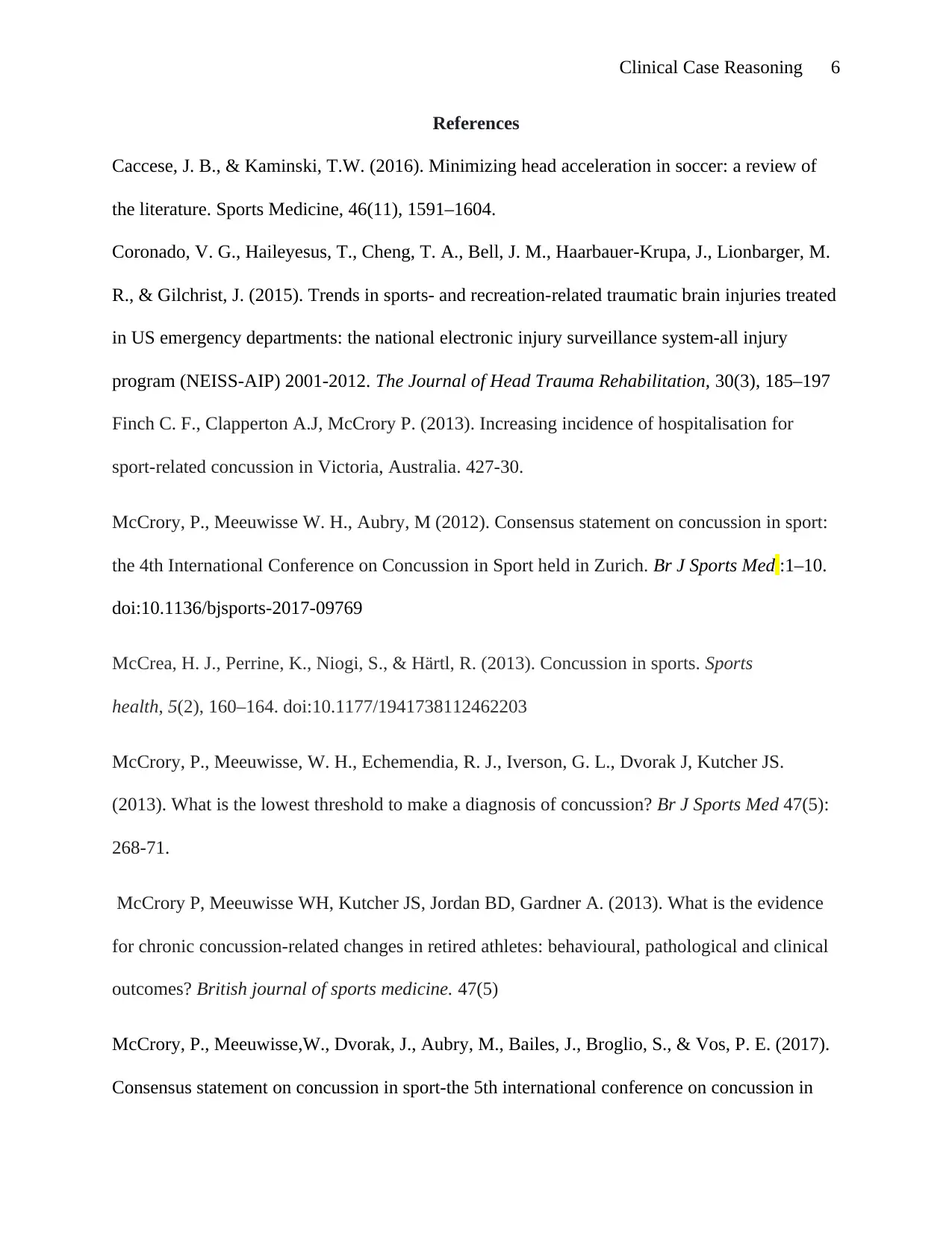
Clinical Case Reasoning 6
References
Caccese, J. B., & Kaminski, T.W. (2016). Minimizing head acceleration in soccer: a review of
the literature. Sports Medicine, 46(11), 1591–1604.
Coronado, V. G., Haileyesus, T., Cheng, T. A., Bell, J. M., Haarbauer-Krupa, J., Lionbarger, M.
R., & Gilchrist, J. (2015). Trends in sports- and recreation-related traumatic brain injuries treated
in US emergency departments: the national electronic injury surveillance system-all injury
program (NEISS-AIP) 2001-2012. The Journal of Head Trauma Rehabilitation, 30(3), 185–197
Finch C. F., Clapperton A.J, McCrory P. (2013). Increasing incidence of hospitalisation for
sport-related concussion in Victoria, Australia. 427-30.
McCrory, P., Meeuwisse W. H., Aubry, M (2012). Consensus statement on concussion in sport:
the 4th International Conference on Concussion in Sport held in Zurich. Br J Sports Med :1–10.
doi:10.1136/bjsports-2017-09769
McCrea, H. J., Perrine, K., Niogi, S., & Härtl, R. (2013). Concussion in sports. Sports
health, 5(2), 160–164. doi:10.1177/1941738112462203
McCrory, P., Meeuwisse, W. H., Echemendia, R. J., Iverson, G. L., Dvorak J, Kutcher JS.
(2013). What is the lowest threshold to make a diagnosis of concussion? Br J Sports Med 47(5):
268-71.
McCrory P, Meeuwisse WH, Kutcher JS, Jordan BD, Gardner A. (2013). What is the evidence
for chronic concussion-related changes in retired athletes: behavioural, pathological and clinical
outcomes? British journal of sports medicine. 47(5)
McCrory, P., Meeuwisse,W., Dvorak, J., Aubry, M., Bailes, J., Broglio, S., & Vos, P. E. (2017).
Consensus statement on concussion in sport-the 5th international conference on concussion in
References
Caccese, J. B., & Kaminski, T.W. (2016). Minimizing head acceleration in soccer: a review of
the literature. Sports Medicine, 46(11), 1591–1604.
Coronado, V. G., Haileyesus, T., Cheng, T. A., Bell, J. M., Haarbauer-Krupa, J., Lionbarger, M.
R., & Gilchrist, J. (2015). Trends in sports- and recreation-related traumatic brain injuries treated
in US emergency departments: the national electronic injury surveillance system-all injury
program (NEISS-AIP) 2001-2012. The Journal of Head Trauma Rehabilitation, 30(3), 185–197
Finch C. F., Clapperton A.J, McCrory P. (2013). Increasing incidence of hospitalisation for
sport-related concussion in Victoria, Australia. 427-30.
McCrory, P., Meeuwisse W. H., Aubry, M (2012). Consensus statement on concussion in sport:
the 4th International Conference on Concussion in Sport held in Zurich. Br J Sports Med :1–10.
doi:10.1136/bjsports-2017-09769
McCrea, H. J., Perrine, K., Niogi, S., & Härtl, R. (2013). Concussion in sports. Sports
health, 5(2), 160–164. doi:10.1177/1941738112462203
McCrory, P., Meeuwisse, W. H., Echemendia, R. J., Iverson, G. L., Dvorak J, Kutcher JS.
(2013). What is the lowest threshold to make a diagnosis of concussion? Br J Sports Med 47(5):
268-71.
McCrory P, Meeuwisse WH, Kutcher JS, Jordan BD, Gardner A. (2013). What is the evidence
for chronic concussion-related changes in retired athletes: behavioural, pathological and clinical
outcomes? British journal of sports medicine. 47(5)
McCrory, P., Meeuwisse,W., Dvorak, J., Aubry, M., Bailes, J., Broglio, S., & Vos, P. E. (2017).
Consensus statement on concussion in sport-the 5th international conference on concussion in
⊘ This is a preview!⊘
Do you want full access?
Subscribe today to unlock all pages.

Trusted by 1+ million students worldwide
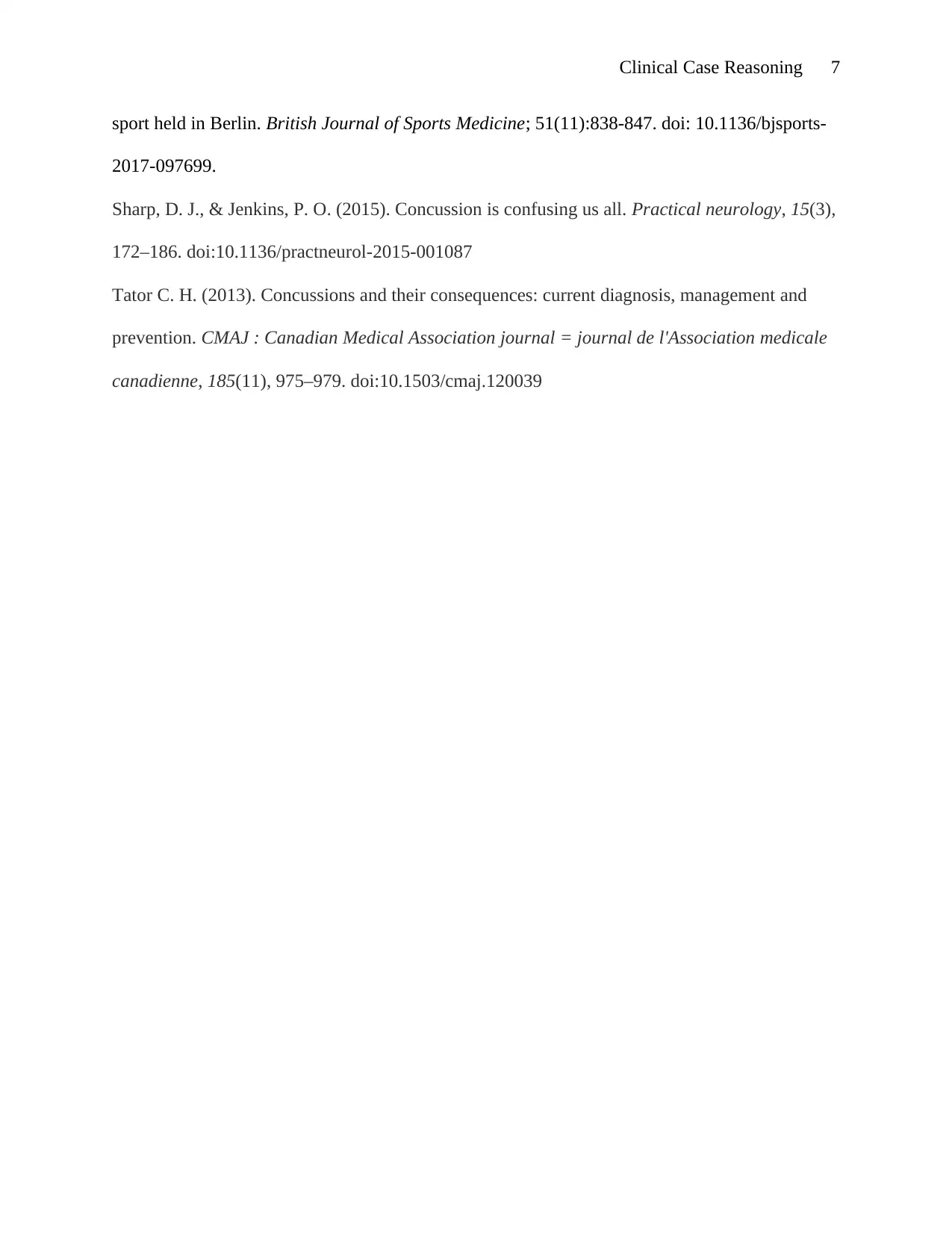
Clinical Case Reasoning 7
sport held in Berlin. British Journal of Sports Medicine; 51(11):838-847. doi: 10.1136/bjsports-
2017-097699.
Sharp, D. J., & Jenkins, P. O. (2015). Concussion is confusing us all. Practical neurology, 15(3),
172–186. doi:10.1136/practneurol-2015-001087
Tator C. H. (2013). Concussions and their consequences: current diagnosis, management and
prevention. CMAJ : Canadian Medical Association journal = journal de l'Association medicale
canadienne, 185(11), 975–979. doi:10.1503/cmaj.120039
sport held in Berlin. British Journal of Sports Medicine; 51(11):838-847. doi: 10.1136/bjsports-
2017-097699.
Sharp, D. J., & Jenkins, P. O. (2015). Concussion is confusing us all. Practical neurology, 15(3),
172–186. doi:10.1136/practneurol-2015-001087
Tator C. H. (2013). Concussions and their consequences: current diagnosis, management and
prevention. CMAJ : Canadian Medical Association journal = journal de l'Association medicale
canadienne, 185(11), 975–979. doi:10.1503/cmaj.120039
1 out of 7
Related Documents
Your All-in-One AI-Powered Toolkit for Academic Success.
+13062052269
info@desklib.com
Available 24*7 on WhatsApp / Email
![[object Object]](/_next/static/media/star-bottom.7253800d.svg)
Unlock your academic potential
Copyright © 2020–2025 A2Z Services. All Rights Reserved. Developed and managed by ZUCOL.





